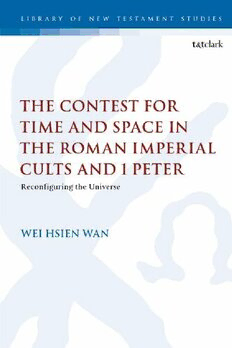
The Contest for Time and Space in the Roman Imperial Cults and 1 Peter: Reconfiguring the Universe PDF
217 Pages·2020·2.273 MB·English
Most books are stored in the elastic cloud where traffic is expensive. For this reason, we have a limit on daily download.
Preview The Contest for Time and Space in the Roman Imperial Cults and 1 Peter: Reconfiguring the Universe
Description:
Wei Hsien Wan builds on the work of David Horrell and Travis Williams for his argument that the letter of 1 Peter engages in a subtle, calculated form of resistance to Rome, which has often gone undetected. Whilst previous discussion of the topic has remained largely focused on the letter’s stance toward specific Roman institutions, such as the emperor, household structures, and the imperial cults, Wan takes the conversation beyond these confines and examines 1 Peter’s critique of the Roman Empire in terms of its ideology or worldview.Using the work of James Scott to conceptualise ideological resistance against domination, Wan considers how the imperial cults of Anatolia and 1 Peter offered distinct constructions of time and space — that is, how they envisioned reality differently. Insofar as these differences led to divergent ways of conceiving the social order, they acquired political power and generated potential for conflict. Wan thus argues that 1 Peter confronts Rome on a cosmic scale with its alternative construal of time and space, and examines the evidence that the Petrine author consciously, if cautiously, interrogated the imperial imagination at its most foundational levels, and set forth in its place a theocentric, Christological understanding of the world.Evaluations of the stance of 1 Peter toward the Roman Empire have for the most part concluded that its author adopted a submissive or conformist posture toward imperial authority and influence. Recently, however, David Horrell and Travis Williams have argued that the letter engages in a subtle, calculated (“polite”) form of resistance to Rome that has often gone undetected. Nevertheless, discussion of the matter has remained largely focused on the letter’s stance toward specific Roman institutions, such as the emperor, household structures, and the imperial cults.Taking the conversation beyond these confines, the present work examines 1 Peter’s critique of the Empire from a wider angle, looking instead to the letter’s ideology or worldview. Using James Scott’s work to think about ideological resistance against domination, I consider how the imperial cults of Anatolia and 1 Peter offered distinct constructions of time and space—that is, how they envisioned reality differently. Insofar as these differences led to divergent ways of conceiving the social order, they acquired political valences and generated potential for conflict. 1 Peter, I argue, confronted Rome on a cosmic scale with its alternative construal of time and space.For each of the axes of time and space, I first investigate how it was constructed in cultic veneration of the emperor, and then read 1 Peter comparatively in light of the findings. Although both sides employed similar strategies in conceptualizing time and space, they parted ways on fundamental points. We have evidence that the Petrine author consciously, if cautiously, interrogated the imperial imagination at its most foundational levels, and set forth in its place a theocentric, Christological understanding of the world.
See more
The list of books you might like
Most books are stored in the elastic cloud where traffic is expensive. For this reason, we have a limit on daily download.
